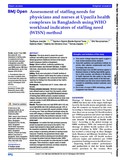| dc.contributor.author | Joarder, Taufique | |
| dc.contributor.author | Bente Kamal Tune, Samiun Nazrin | |
| dc.contributor.author | Nuruzzaman, Md | |
| dc.contributor.author | Alam, Sabina | |
| dc.contributor.author | de Oliveira Cruz, Valeria | |
| dc.contributor.author | Zapata, Tomas | |
| dc.date.accessioned | 2022-05-09T04:38:01Z | |
| dc.date.available | 2022-05-09T04:38:01Z | |
| dc.date.copyright | 2020 | |
| dc.date.issued | 2020-02-13 | |
| dc.identifier.citation | Joarder, T., Tune, S. N. B. K., Nuruzzaman, M., Alam, S., De Oliveira Cruz, V., & Zapata, T. (2020). Assessment of staffing needs for physicians and nurses at upazila health complexes in Bangladesh using WHO workload indicators of staffing need (WISN) method. BMJ Open, 10(2) doi:10.1136/bmjopen-2019-035183 | en_US |
| dc.identifier.uri | http://hdl.handle.net/10361/16578 | |
| dc.description | This article was published in The BMJ Open [ © Author(s) (or their employer(s)) 2020. Re-use permitted under CC BY. Published by BMJ.] and the definite version is available at: http://dx.doi.org/10.1136/bmjopen-2019-035183 The Journal's website is at: https://bmjopen.bmj.com/content/10/2/e035183 | en_US |
| dc.description.abstract | Objective This study aimed to assess the current
workload and staffing need of physicians and nurses for
delivering optimum healthcare services at the Upazila
Health Complexes (UpHCs) in Bangladesh.
Design Mixed-methods, combining qualitative (eg,
document reviews, key informant interviews, in-depth
interviews, observations) and quantitative methods (timemotion survey).
Setting Study was conducted in 24 health facilities of
Bangladesh. However, UpHCs being the nucleus of primary
healthcare in Bangladesh, this manuscript limits itself to
reporting the findings from the providers at four UpHCs
under this project.
Participants 18 physicians and 51 nurses, males and
females.
Primary outcome measures Workload components
were defined based on inputs from five experts, refined
by nine service providers. Using WHO Workload Indicator
of Staffing Need (WISN) software, standard workload,
category allowance factor, individual allowance factor, total
required number of staff, WISN difference and WISN ratio
were calculated.
Results Physicians have very high (WISN ratio 0.43) and
nurse high (WISN ratio 0.69) workload pressure. 50% of
nurses’ time are occupied with support activities, instead
of nursing care. There are different workloads among the
same staff category in different health facilities. If only the
vacant posts are filled, the workload is reduced. In fact,
sanctioned number of physicians and nurses is more than
actual need.
Conclusions It is evident that high workload pressures
prevail for physicians and nurses at the UpHCs. This
reveals high demand for these health workforces in
the respective subdistricts. WISN method can aid the
policy-makers in optimising utilisation of existing human
resources. Therefore, the government should adopt
flexible health workforce planning and recruitment policy
to manage the patient load and disease burden. WISN
should, thus, be incorporated as a planning tool for health
managers. There should be a regular review of health
workforce management decisions, and these should be
amended based on periodic reviews. | en_US |
| dc.language.iso | en_US | en_US |
| dc.publisher | BMJ Journals | en_US |
| dc.relation.uri | https://bmjopen.bmj.com/content/10/2/e035183 | |
| dc.subject | Health policy | en_US |
| dc.subject | Health services administration & management | en_US |
| dc.subject | Human resource management | en_US |
| dc.subject | Public health | en_US |
| dc.title | Assessment of staffing needs for physicians and nurses at Upazila health complexes in Bangladesh using WHO workload indicators of staffing need (WISN) method | en_US |
| dc.type | Journal Article | en_US |
| dc.description.version | Published | |
| dc.contributor.department | Brac James P. Grant School of Public Health | |
| dc.identifier.doi | http://dx.doi.org/10.1136/bmjopen-2019-035183 | |
| dc.relation.journal | BMJ Open | |

